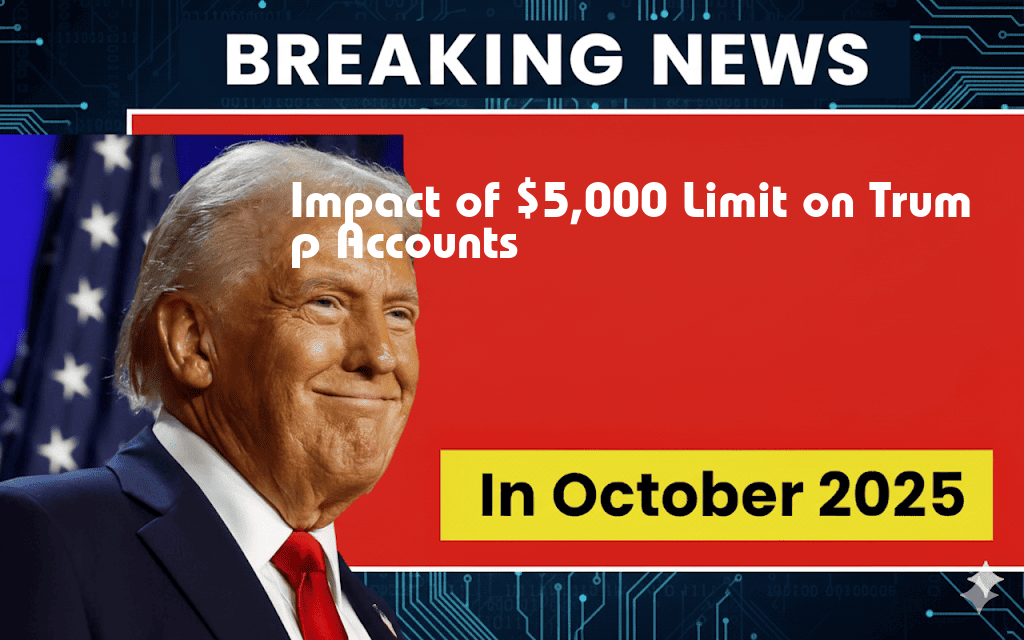

The recent announcement of a $5,000 annual contribution limit to accounts associated with former President Donald Trump has sparked a wave of discussions regarding its implications for political funding and campaign finance. This new regulation, aimed at enhancing transparency and accountability, marks a significant shift in the landscape of political contributions. As individuals and organizations navigate this change, understanding the potential impact on fundraising strategies, donor engagement, and overall political dynamics becomes crucial. This article delves into the nuances of this contribution limit, examining its effects on Trump’s political machinery and the broader implications for campaign finance in the United States.
Background on Contribution Limits
Federal regulations governing political contributions have long been a contentious issue in American politics. The introduction of limits is designed to prevent undue influence from wealthy donors while encouraging broader participation from average citizens. The Federal Election Commission (FEC) oversees these limits, which can vary depending on the type of campaign and the status of the candidate.
What the New Limit Entails
The $5,000 annual contribution limit specifically applies to accounts connected to Trump, including his political action committees (PACs) and other fundraising entities. This cap is likely to affect various stakeholders in the political landscape:
- Donors: Individuals wishing to contribute will have to strategize their donations more carefully.
- Campaigns: Fundraising efforts may need to adapt to ensure sustainability despite the lower limits.
- Political Action Committees: PACs may face challenges in rallying support and maintaining influence.
Impact on Trump’s Political Strategy
The new limit may compel Trump’s team to rethink their fundraising approach. Historically, Trump has relied on a combination of small donations and large contributions from influential backers. With the cap in place, the emphasis may shift more towards mobilizing grassroots support.
Strategies for Adaptation
To mitigate the effects of the contribution limit, Trump’s campaign may explore several strategies:
- Enhanced Digital Engagement: Utilizing online platforms to reach a wider audience can help draw in smaller donations.
- Membership Programs: Implementing tiered membership programs may incentivize loyal supporters to contribute regularly.
- Event Fundraising: Organizing high-profile events could attract larger groups of attendees, bolstering contributions.
Broader Implications for Campaign Finance
The $5,000 limit not only impacts Trump’s fundraising but also sets a precedent for future political campaigns. As the conversation around campaign finance reform intensifies, this cap may influence how other candidates approach their fundraising strategies.
Potential Reactions from Other Candidates
In light of these changes, political analysts anticipate varied responses from other candidates:
- Increased Scrutiny: Candidates may face heightened scrutiny regarding their fundraising practices.
- Innovative Fundraising Models: Other campaigns might introduce new funding models to adapt to similar constraints.
- Collaborative Efforts: Candidates may band together to advocate for more comprehensive reforms in campaign finance.
The Future of Political Contributions
As the dynamics of political contributions evolve, the implications of the $5,000 annual limit extend beyond Trump’s accounts. This change highlights ongoing debates about the integrity of campaign finance and the necessity for reforms that ensure fair competition among candidates. The FEC’s role in maintaining transparency will be critical as the political landscape continues to shift.
Conclusion
The $5,000 annual contribution limit to Trump accounts is a noteworthy development in the realm of political finance, with potential ripple effects for candidates across the political spectrum. As stakeholders adjust to these new rules, the focus shifts to how this limitation will shape the future of political contributions and campaign strategies in the United States.
For additional information on campaign finance regulations, visit the Wikipedia page on Campaign Finance or read more from Forbes’ analysis on campaign finance reform.
Frequently Asked Questions
What is the $5,000 annual contribution limit to Trump accounts?
The $5,000 annual contribution limit to Trump accounts refers to the maximum amount an individual can contribute to accounts associated with Donald Trump’s political campaigns or related organizations within a given year.
How does the contribution limit affect political fundraising?
The contribution limit can significantly impact political fundraising efforts as it restricts the amount of money that supporters can donate, potentially limiting the resources available for campaign activities and outreach.
Are there any exceptions to the $5,000 contribution limit?
While the general rule is a $5,000 contribution limit, there may be specific exceptions or additional regulations that apply based on local laws or the type of campaign financing involved, which should be consulted for detailed guidance.
What are the implications of exceeding the contribution limit?
Exceeding the contribution limit can lead to serious legal consequences, including fines and possible criminal charges, as it violates campaign finance laws designed to ensure transparency and fairness in political donations.
How can individuals contribute to Trump accounts within the legal limits?
Individuals can contribute to Trump accounts by ensuring their donations do not exceed the $5,000 annual limit, keeping accurate records of their contributions, and following all applicable campaign finance regulations to remain compliant.




